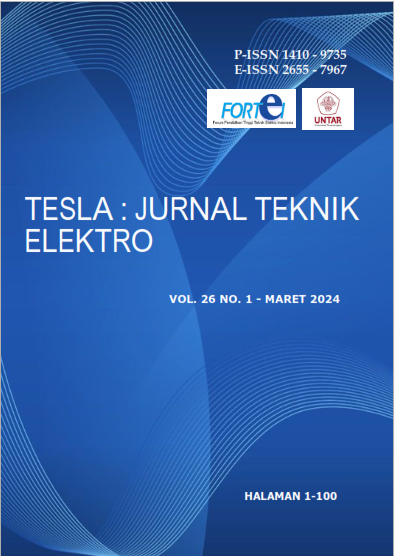DESIGN OF ARDUINO BASED PORTABLE ELECTROCARDIOGRAM (ECG) MONITORING DEVICE
Main Article Content
Abstract
Electrocardiogram is a medical device to measure heart rhythm and electrical activity of the heart. Electrocardiogram is recommended for patients who have symptoms of chest pain, palpitations, heart rhythm disturbances (arrhythmias), shortness of breath, dizziness, weakness, and fatigue quickly to find out what diseases are lodged in the body need direct examination, especially checking heart rhythm. However, some hospitals or puskesmas located in remote areas do not have these tools because of various factors, especially the price of the tool is too expensive. This research is a research development tool for monitoring human heart rate using the AD8232 sensor which functions to read heart rate rhythm, by attaching a lead or receiver of heart electricity to a predetermined part of the body based on the theory of the Einthoven triangle. The results showed that the average error percentage was 1.99%. By using several sampling frequencies, namely, 250 Hz, 500 Hz, and 1000 Hz for 1000 sampling data ECG (Electrocardiogram) signals, results were obtained from cross-correlation testing with a level of data accuracy between the sender and receiver of data of 100 percent. Furthermore, the android application to store heart rate rhythm data and create heart rate rhythm username data
Abstrak
Elektrokardiogram merupakan alat medis untuk mengukur irama jantung dan aktivitas listrik jantung. Elektrokardiogram direkomendasikan kepada pasien yang memiliki gejala nyeri dada, jantung berdebar, gangguan irama jantung (aritmia), sesak nafas, pusing, badan lemas, dan cepat lelah untuk mengetahui penyakit apa saja yang bersarang didalam tubuh perlu adanya pemeriksaan secara langsung, terutama memeriksa irama jantung. Akan tetapi, sebagian rumah sakit atau puskesmas yang berada pada daerah terpencil tidak memiliki alat tersebut karena berbagai faktor terutama harga dari alat tersebut terlalu mahal. Penelitian ini merupakan penelitian pengembangan alat monitoring denyut jantung manusia menggunakan sensor AD8232 yang berfungsi untuk membaca irama detak jantung, dengan cara menempelkan lead atau alat penerima implus listrik jantung pada bagian tubuh yang telah ditentukan berdasarkan teori segitiga Einthoven. Hasil penelitian menunjukkan bahwa persentase nilai rata-rata error sebesar 1,99%. Dengan menggunakan beberapa frekuensi sampling yaitu, 250 Hz, 500 Hz, dan 1000 Hz untuk 1000 data sampling sinyal ECG (Electrocardiogram), didapatkan hasil dari pengujian cross-correlation dengan tingkat keakurasian data antara pengirim dan penerima data sebesar 100 persen. Selanjutnya aplikasi android untuk menyimpan data irama detak jantung serta membuat data nama pengguna irama detak jantung.
Article Details
Section

This work is licensed under a Creative Commons Attribution-ShareAlike 4.0 International License.
This work is licensed under a TESLA: Jurnal Teknik Elektro Creative Commons Attribution-ShareAlike 4.0 International License. 
How to Cite
References
C. W. Tsao et al., “Heart Disease and Stroke Statistics—2023 Update: A Report From the American Heart Association,” Circulation, vol. 147, no. 8, Feb. 2023, doi: 10.1161/CIR.0000000000001123.
E. J. Benjamin et al., “Heart Disease and Stroke Statistics—2019 Update: A Report From the American Heart Association,” Circulation, vol. 139, no. 10, Mar. 2019, doi: 10.1161/CIR.0000000000000659.
G. Cosoli, S. Spinsante, F. Scardulla, L. D’Acquisto, and L. Scalise, “Wireless ECG and cardiac monitoring systems: State of the art, available commercial devices and useful electronic components,” Measurement, vol. 177, p. 109243, Jun. 2021, doi: 10.1016/j.measurement.2021.109243.
E. Paket, K. Ozlem, H. Elmoughni, A. Atalay, O. Atalay, and G. Ince, “ECG Monitoring System Using Textile Electrodes,” in 2020 28th Signal Processing and Communications Applications Conference (SIU), IEEE, Oct. 2020, pp. 1–4. doi: 10.1109/SIU49456.2020.9302506.
M. Etemadi, O. T. Inan, J. A. Heller, S. Hersek, L. Klein, and S. Roy, “A Wearable Patch to Enable Long-Term Monitoring of Environmental, Activity and Hemodynamics Variables,” IEEE Trans Biomed Circuits Syst, vol. 10, no. 2, pp. 280–288, Apr. 2016, doi: 10.1109/TBCAS.2015.2405480.
Z.-H. -, R. Qureshi, M. Nawaz, F. Yar, N. Tunio, and M. Uzair, “Analysis of ECG Signal Processing and Filtering Algorithms,” International Journal of Advanced Computer Science and Applications, vol. 10, no. 3, 2019, doi: 10.14569/IJACSA.2019.0100370.
R. M. Merchant et al., “Part 1: Executive Summary: 2020 American Heart Association Guidelines for Cardiopulmonary Resuscitation and Emergency Cardiovascular Care,” Circulation, vol. 142, no. 16_suppl_2, Oct. 2020, doi: 10.1161/CIR.0000000000000918.
M. Dominguez, “Electrocardiogram (ECG).” Accessed: Apr. 01, 2024. [Online]. Available: https://step1.medbullets.com/cardiovascular/108017/electrocardiogram-ecg
D. Permana, “DESAIN DAN IMPLEMENTASI PERANCANGAN ELEKTROKARDIOGRAF (EKG) BERBASIS BLUETOOTH”, Accessed: Apr. 01, 2024. [Online]. Available: https://journal.uinsgd.ac.id/index.php/ahjop/article/view/309
T. Ajam, “Electrocardiography.” Accessed: Apr. 01, 2024. [Online]. Available: https://emedicine.medscape.com/article/1894014-overview?form=fpf#showall
CaseyTheRobot, “AD8232 Heart Rate Monitor Hookup Guide.” Accessed: Apr. 01, 2024. [Online]. Available: https://learn.sparkfun.com/tutorials/ad8232-heart-rate-monitor-hookup-guide/all
Texas Instruments, “ADS1115: Ultra-Small, Low-Power, I2C-Compatible, 860-SPS, 16-Bit ADCs.” Accessed: Apr. 01, 2024. [Online]. Available: https://www.ti.com/product/ADS1115
P. Daponte, L. De Vito, G. Iadarola, and F. Picariello, “ECG Monitoring Based on Dynamic Compressed Sensing of Multi-Lead Signals,” Sensors, vol. 21, no. 21, p. 7003, Oct. 2021, doi: 10.3390/s21217003.
N. Das and M. Chakraborty, “Performance analysis of FIR and IIR filters for ECG signal denoising based on SNR,” in 2017 Third International Conference on Research in Computational Intelligence and Communication Networks (ICRCICN), IEEE, Nov. 2017, pp. 90–97. doi: 10.1109/ICRCICN.2017.8234487.
W. Xiao, L. Yu, R. Joseph, and V. Giurgiutiu, “Fatigue-Crack Detection and Monitoring through the Scattered-Wave Two-Dimensional Cross-Correlation Imaging Method Using Piezoelectric Transducers,” Sensors, vol. 20, no. 11, p. 3035, May 2020, doi: 10.3390/s20113035.

